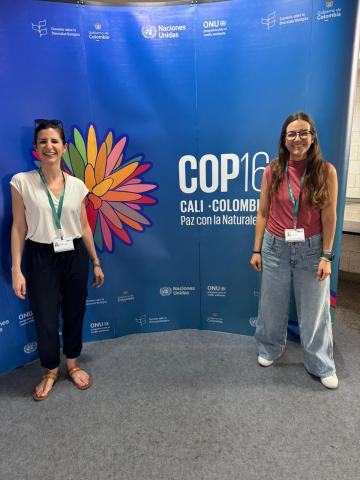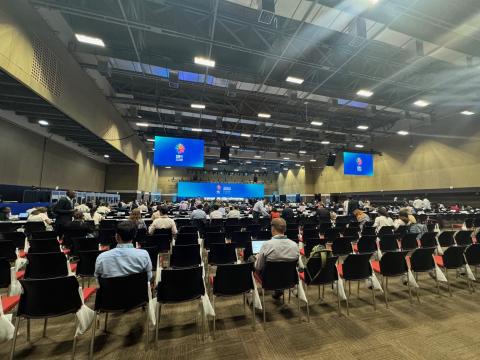A Penn delegation at COP16, the United Nations Biodiversity Conference
EII and Penn Global partnered to secure observer status for Penn at the Convention on Biological Diversity Conference of the Parties for the first time this year. (Image at right: Fernanda Jimenez)

EII and Penn Global partnered to secure observer status for Penn at the Convention on Biological Diversity Conference of the Parties for the first time this year. A delegation from Penn including Fernanda Jiménez and Carolina Angel Botero, both of the Center for Latin American and LatinX Studies (CLALS), attended the global gathering in Cali, Colombia. Amanda Lloyd of the Penn Institute for Urban Research and alum Daniel Ruiz de la Concha were among other Penn affiliates at COP16. Here are short impressions from members of the delegation about their takeaways and experience in Cali:
Fernanda Jiménez, visiting fellow, CLALS
It was really a great experience to be able to observe the negotiations, perceive how different delegations saw the process and how so many different interest-groups got together to have a say in the result. I also attended a lot of the side events, where academia, civil society and even the private sector discussed a lot of the most recent developments on many topics, including digital sequenced information, the role of environmental defenders, biodiversity finance and ocean conservation.

Carolina Angel Botero, postdoctoral fellow, CLALS
As I entered the venue where COP16 for the CBD was taking place, my thoughts were occupied with the numerous ways in which diverse definitions of nature can lead to a variety of realities. In the midst of these complex negotiations, it became clear that scientific knowledge had cultivated a consensus around the concept of biodiversity. This agreement now serves as a vital foundation for our discussions on a range of urgent global issues, including sustainable development, the use of genetic resources, climate change adaptation, and the alarming pace of species extinction.
Conference Room Papers, or CRPs, are the key documents on which parties discuss before formal plenary. Yet, for many attendees, these sessions can feel abstract and detached from real-world consequences. The ongoing debates over wording may appear tedious, locked in an endless cycle of semantic negotiation. Still, it's essential to understand that each term carries substantial weight; they represent funding distributions, mechanisms for public involvement, developmental initiatives, and local legislation.
This brings up a question that I am exploring: How does the exercise of writing and grammar, which often grapples with the nuances of translation—considering that words can have varied meanings across languages and cultural contexts—shape our understanding of biodiversity? Additionally, how does the very act of defining biodiversity influence the way we perceive it? The subtle complexities involved in this process can ultimately transform our interactions with and responses to the pressing environmental challenges we face today.
Definitions of biodiversity are primarily shaped by scientific consensus, with the most widely accepted definition coming from the United Nations Convention on Biological Diversity. This definition states that biodiversity is "the variability among living organisms from all sources." How does the grammar used in the negotiation process connect to this definition of biodiversity? More specifically, how is biodiversity being created and redefined during these discussions? I am currently exploring these conceptual questions to understand the different meanings of biodiversity and its response to environmental crises
After a long workday that stretched late into the night, attendees applauded on the morning of November 2 when the Colombian Minister of Environment, who led the session, celebrated the inclusion of the phrase “Communities of African Descent” in Article 8j. This addition recognizes the contributions of Afro-descendant communities to the protection of biodiversity, alongside those of indigenous and local communities. Although the term "Afro-descendant" sparked debate throughout the 15-day event in Cali, a new subsidiary body has been established to enhance the participation of indigenous, Afro-descendant, and local communities in the development of the agreement.

In the final days of the conference, Cali also celebrated the establishment of the “Cali Fund,” which had been discussed during COP15 but became more defined by the end of COP16. The funds collected will be used to share the benefits derived from the use of genetic resources through digital sequencing information (DSI). According to a statement from the United Nations after COP 16, “This complex decision addresses how industries in pharmaceuticals, biotechnology, animal and plant breeding, and others benefiting from DSI should share those benefits with developing countries, Indigenous Peoples, and local communities.” However, additional intersectional meetings will be necessary to clarify the fund's operations and how to distribute the benefits.
Regarding compliance with commitments made under the Kunming-Montreal Global Biodiversity Framework, only 44 out of the 196 delegations that are members of the Convention on Biological Diversity have submitted their National Biodiversity Strategy and Action Plans. This document outlines how each country intends to implement the current agreement, which includes Target 3 on the 30x30 initiative aimed at protecting 30% of the planet’s biodiversity by 2030.
***
EII is planning an informal post-event roundtable discussion to hear more from the attendees. Reach out to EII Director Katie Unger Baillie at kbaillie@upenn.edu if you are interested in joining.
Further reading on Penn's involvement at COP16:
- Penn IUR, the United Nations Environment Programme unveil new framework to address gap in urban nature finance (Penn Today)
- How is the world working to save biodiversity? (Penn Today)
- Video recording of EII/CLALS event, How is the World Working to Save Biodiversity? (Vimeo)